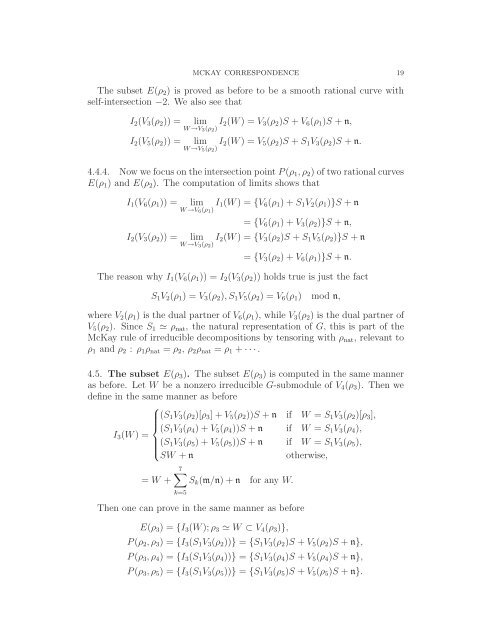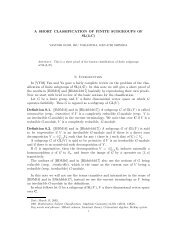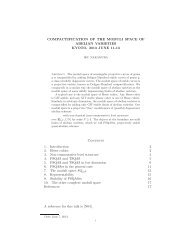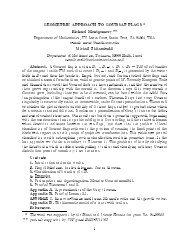mckay correspondence iku nakamura
mckay correspondence iku nakamura
mckay correspondence iku nakamura
- No tags were found...
Create successful ePaper yourself
Turn your PDF publications into a flip-book with our unique Google optimized e-Paper software.
MCKAY CORRESPONDENCE 19The subset E(ρ 2 ) is proved as before to be a smooth rational curve withself-intersection −2. We also see thatI 2 (V 3 (ρ 2 )) =I 2 (V 5 (ρ 2 )) =lim I 2(W )=V 3 (ρ 2 )S + V 6 (ρ 1 )S + n,W →V 3 (ρ 2 )lim I 2 (W )=V 5 (ρ 2 )S + S 1 V 3 (ρ 2 )S + n.W →V 5 (ρ 2 )4.4.4. Now we focus on the intersection point P (ρ 1 ,ρ 2 ) of two rational curvesE(ρ 1 ) and E(ρ 2 ). The computation of limits shows thatI 1 (V 6 (ρ 1 )) =I 2 (V 3 (ρ 2 )) =lim I 1 (W )={V 6 (ρ 1 )+S 1 V 2 (ρ 1 )}S + nW →V 6 (ρ 1 )= {V 6 (ρ 1 )+V 3 (ρ 2 )}S + n,lim I 2 (W )={V 3 (ρ 2 )S + S 1 V 5 (ρ 2 )}S + nW →V 3 (ρ 2 )= {V 3 (ρ 2 )+V 6 (ρ 1 )}S + n.The reason why I 1 (V 6 (ρ 1 )) = I 2 (V 3 (ρ 2 )) holds true is just the factS 1 V 2 (ρ 1 )=V 3 (ρ 2 ),S 1 V 5 (ρ 2 )=V 6 (ρ 1 ) mod n,where V 2 (ρ 1 ) is the dual partner of V 6 (ρ 1 ), while V 3 (ρ 2 ) is the dual partner ofV 5 (ρ 2 ). Since S 1 ≃ ρ nat , the natural representation of G, this is part of theMcKay rule of irreducible decompositions by tensoring with ρ nat , relevant toρ 1 and ρ 2 : ρ 1 ρ nat = ρ 2 , ρ 2 ρ nat = ρ 1 + ···.4.5. The subset E(ρ 3 ). The subset E(ρ 3 ) is computed in the same manneras before. Let W be a nonzero irreducible G-submodule of V 4 (ρ 3 ). Then wedefine in the same manner as before⎧(S 1 V 3 (ρ 2 )[ρ 3 ]+V 5 (ρ 2 ))S + n if W = S 1 V 3 (ρ 2 )[ρ 3 ],⎪⎨(S 1 V 3 (ρ 4 )+V 5 (ρ 4 ))S + n if W = S 1 V 3 (ρ 4 ),I 3 (W )=(S 1 V 3 (ρ 5 )+V 5 (ρ 5 ))S + n if W = S 1 V 3 (ρ 5 ),⎪⎩SW + notherwise,7∑= W + S k (m/n)+n for any W.k=5Then one can prove in the same manner as beforeE(ρ 3 )={I 3 (W ); ρ 3 ≃ W ⊂ V 4 (ρ 3 )},P (ρ 2 ,ρ 3 )={I 3 (S 1 V 3 (ρ 2 ))} = {S 1 V 3 (ρ 2 )S + V 5 (ρ 2 )S + n},P (ρ 3 ,ρ 4 )={I 3 (S 1 V 3 (ρ 4 ))} = {S 1 V 3 (ρ 4 )S + V 5 (ρ 4 )S + n},P (ρ 3 ,ρ 5 )={I 3 (S 1 V 3 (ρ 5 ))} = {S 1 V 3 (ρ 5 )S + V 5 (ρ 5 )S + n}.





